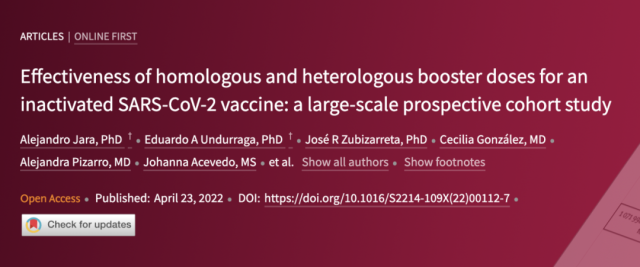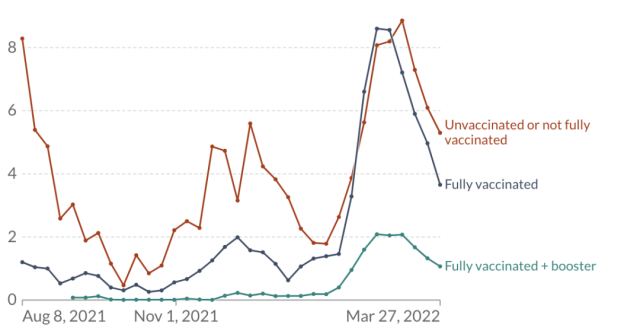COVID-19 vaccine: Chile released real-world data on nearly 9 million people
- Normal Liver Cells Found to Promote Cancer Metastasis to the Liver
- Nearly 80% Complete Remission: Breakthrough in ADC Anti-Tumor Treatment
- Vaccination Against Common Diseases May Prevent Dementia!
- New Alzheimer’s Disease (AD) Diagnosis and Staging Criteria
- Breakthrough in Alzheimer’s Disease: New Nasal Spray Halts Cognitive Decline by Targeting Toxic Protein
- Can the Tap Water at the Paris Olympics be Drunk Directly?
COVID-19 vaccine: Chile released real-world data on nearly 9 million people
- Should China be held legally responsible for the US’s $18 trillion COVID losses?
- CT Radiation Exposure Linked to Blood Cancer in Children and Adolescents
- FDA has mandated a top-level black box warning for all marketed CAR-T therapies
- Can people with high blood pressure eat peanuts?
- What is the difference between dopamine and dobutamine?
- How long can the patient live after heart stent surgery?
COVID-19 vaccine: Chile released real-world data on nearly 9 million people.
This is one of the first studies to test the effectiveness of a booster shot of an inactivated vaccine.
Following Hong Kong, Singapore, and Brazil, Chile has recently released the results of a large-scale real-world comparison of the efficacy of inactivated vaccines.
On April 23, Chilean researchers published a paper in The Lancet Global Health , summarizing and analyzing the vaccination and infection status of nearly 9 million people. Real-world protection data from booster vaccination with vaccine, Pfizer mRNA vaccine, and AstraZeneca adenovirus vaccine.

The results showed that on the basis of two doses of inactivated vaccine, compared with continuing to inoculate a third dose of inactivated vaccine, heterologous vaccination with the other two vaccines can improve the protective efficacy by about 20% to 30%. .
Comparison of the effectiveness of three doses of different vaccines
Chile is one of the countries with the largest number of Chinese inactivated vaccines overseas.
According to Gob.cl, the official website of the Chilean government, as of January 21, 2022 local time, the total number of doses of Chile’s vaccines exceeded 45.94 million, of which 25.18 million doses of Sinovac vaccine. This vaccination base also makes Chile the best overseas “sample country” to evaluate the efficacy of inactivated vaccines.
After excluding those who received only one shot of the vaccine, the researchers further selected a total of 8,767,194 subjects in the “Delta Period” from February 2 to November 10, 2021, and divided them into three groups;
- Unvaccinated, 1,071,998;
- 2,889,319 people who received only two doses of inactivated vaccine;
- On the basis of two doses of inactivated vaccine, 186,946, 2,019,260 and 1,921,340 were vaccinated with the third dose of inactivated vaccine, mRNA vaccine and adenovirus vaccine, respectively;
After comprehensive adjustment for variables such as age, gender, living area, economic status, and health status, the researchers found that compared with unvaccinated people:
In terms of preventing infection, the effectiveness of the three-shot inactivated vaccine was 78.8%. The efficacy of the third booster with mRNA vaccine or adenovirus vaccine was 96.5% and 93.2%, respectively.
- In terms of preventing hospitalization, the three groups of data are 86.3%, 96.1% and 97.7% respectively;
- Severe disease prevention (based on admission to ICU) , 92.2%, 96.2%, and 98.9%, respectively;
- The deaths from infection were 86.7%, 96.8% and 98.1% respectively.
The effect of heterologous vaccination is significantly improved
In July 2021, another real-world study published by Chilean researchers showed that within three months after inoculation with two doses of inactivated vaccine, the effective rates of infection prevention, hospitalization prevention, severe illness prevention, and death prevention were different. were 65.9%, 87.5%, 90.3%, and 86.3%.
But as time passed and the new coronavirus strain mutated, the protective effect of the vaccine also began to decline.
Since Chile has completed the whole process of vaccination for a large number of people in the early stage of the epidemic, according to the data of Our World In Data, the anti-death protection provided by the vaccine has been greatly attenuated during the “invasion” of the Omicron variant at the beginning of the year. .
In contrast, Chile began to gradually implement a booster immunization plan in the second half of 2021, and the death rate from the infection has remained relatively low among those who received the booster shot.

Although this latest real-world study did not involve the Omicron variant, the researchers further used the “basic immunity” after two doses of inactivated vaccine as a control to explore the effects of different booster vaccination schemes. The protection effect is improved.
The results of the study showed that compared with two doses of inactivated vaccine, the third dose of homologous booster, that is, another dose of inactivated vaccine, had relative efficacy of 63.8% in preventing infection, preventing hospitalization, preventing severe illness, and preventing death, respectively. 59.3%, 71.2% and 62.7%.
The effect of the heterologous vaccination program is much better. The relative efficacy of boosting with mRNA vaccine is 93.5%, 86.6%, 84.1%, and 90.7%; with adenovirus vaccine, the relative efficacy is 88.4% and 93%, respectively. %, 95.9%, 94.7%;
Researchers in Chile say this is one of the first studies to test the effectiveness of booster shots of the inactivated vaccine. Combining the above series of data, they believe that:
There is growing evidence that the protective effect of the COVID-19 vaccine may decrease over time, which is particularly worrying for inactivated vaccines, because the initial protective effect is lower than many other technical routes ‘s vaccine.
As booster regimens have been introduced in many countries, our findings suggest that both homologous or heterologous boosters provide high levels of protection for those who have completed two doses of the inactivated vaccine, but the heterologous booster regimen does not. The protection effect is more significant and should be considered as a priority in the strengthening program.
Can’t enter public places without vaccinations
It is worth mentioning that, according to the statistics of Argentina’s “Nation”, Chile’s full-course vaccination rate currently ranks sixth in the world, covering 95.88% of the country’s population, and the proportion of booster shots is as high as about 90%.
Coupled with the more than 3.5 million COVID-19 infections accumulated since the outbreak of the epidemic, Chile’s population immunity level has ranked second in the world. After surviving the peak of the Omicron variant infection at the beginning of the year, Chile has ushered in a new stage of epidemic prevention.
On April 11, the Chilean Ministry of Health proposed a new “step-by-step” epidemic prevention plan, dividing the impact of the epidemic into three scenarios, each of which adopts different epidemic prevention strategies.
Low health impact phase: In-hospital “respiratory counseling” below seasonal thresholds and ICU occupancy rates are low:
The mask order for non-intensive outdoor spaces will be lifted, and the wearing of masks will continue to be mandatory in closed public spaces. Social distancing restrictions at large events have been lifted.
Moderate health impact phase: Post-COVID-19 medical visits stress the healthcare system, above seasonal thresholds but below alert levels, with moderate to high ICU occupancy rates:
The mask order for non-intensive outdoor spaces will be lifted, and the wearing of masks will continue to be mandatory in closed public spaces. In large-scale events, the venue capacity ratio should at least meet the requirement that the physical distance between people can exceed 1 meter, and large-scale events can accommodate up to 10,000 people.
High health impact stage: high and growing COVID-19 infection and death rates are predicted to have severe impacts on the healthcare system.
The wearing of masks is mandatory in both indoor and outdoor public spaces. The venue capacity ratio should at least meet the physical distance between people, which can exceed 1.5 meters. Large-scale events can accommodate up to 200 people.
But in the above three scenarios, no matter what stage you are in, you need to show a “pass” to enter a public place, and the condition that must be met to obtain a pass is to be vaccinated.
References:
[1] Effectiveness of homologous and heterologous booster doses for an inactivated SARS-CoV-2 vaccine: a large-scale prospective cohort study, https://www.thelancet.com/journals/langlo/article/PIIS2214-109X(22) 00112-7/fulltext#%20
[2] Effectiveness of an Inactivated SARS-CoV-2 Vaccine in Chile, https://www.nejm.org/doi/full/10.1056/NEJMoa2107715
[3] Covid-19 en Chile: casos de coronavirus y vacunación al 22 de abril, https://www.lanacion.com.ar/el-mundo/covid-19-en-chile-casos-de-coronavirus-y -vacunacion-al-22-de-abril-nid23042022/
COVID-19 vaccine: Chile released real-world data on nearly 9 million people
(source:internet, reference only)
Disclaimer of medicaltrend.org
Important Note: The information provided is for informational purposes only and should not be considered as medical advice.



